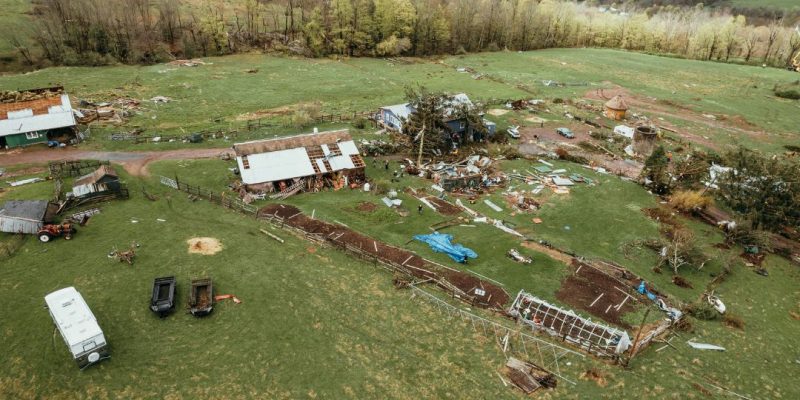
Storm Éowyn, a tempest of remarkable ferocity, has swept across Northern Ireland and the Republic of Ireland, leaving a trail of disruption and prompting the issuance of unprecedented red weather warnings across both regions.
For the first time, authorities have deemed conditions so treacherous that the highest level of alert has been activated, a stark indicator of the grave danger posed by the storm’s powerful winds.
The Met Office issued the red alert for Northern Ireland until 14:00 GMT, emphasizing the severity of the situation.
Power grid buckles under Éowyn’s onslaught
The sheer force of Storm Éowyn is immediately evident in the staggering number of properties left without power.
In Northern Ireland, over 93,000 homes and businesses have been plunged into darkness, their electricity supply severed by the storm’s relentless winds.
The Republic of Ireland faces an even more dire situation, with more than 715,000 properties currently without power.
This mass outage demonstrates the storm’s capacity to disable critical infrastructure and disrupt daily life for a vast population.
Unleashing unprecedented wind gusts
The storm’s primary weapon is its ferocious winds, which have shattered previous records in the Republic of Ireland.
At Mace Head, County Galway, hurricane-force sustained winds of 85 mph (137 km/h) and gusts reaching a staggering 114 mph (183 km/h) have been recorded.
These figures eclipse the previous record of 81 mph (131 km/h) sustained wind and 113 mph (182 km/h) gusts set in Limerick in 1945.
In Northern Ireland, the strongest gust of wind recorded was 92.2mph (148km/h) at Killowen in County Down, marking the most potent gust since a 93mph (150km/h) measurement at Ballykelly in 1998.
While falling short of the all-time record of 124mph (199km/h) at Kilkeel in 1974, the winds have been devastating.
Life disrupted: closures and cancellations
The severity of Storm Éowyn has led to widespread closures and cancellations.
Educational institutions, including schools, colleges and universities across Northern Ireland have closed their doors, whilst most hospital appointments have been cancelled as significant disruption is expected.
Businesses have followed suit with major supermarkets like Lidl, Tesco, and Sainsbury’s shuttering for the day.
Public transport has ground to a halt, with Translink canceling all bus and train services during the red alert.
In Londonderry, a wall collapse on Northland Crescent led to the area being cordoned off, damaging a parked vehicle.
Authorities issue urgent safety guidance
The Police Service of Northern Ireland (PSNI) has issued stern advice, urging citizens to “take all necessary precautions” and avoid all but essential travel.
They recommend ensuring devices are charged, keeping emergency lighting accessible, having extra blankets available, and checking on vulnerable neighbors.
The UK government activated its Emergency Alert system, notifying 4.5 million people in Northern Ireland and Scotland.
Gardaí in the Republic of Ireland are also attending to the situation, responding to reports of traffic accidents while advising people to “shelter in place”.
First Minister Michelle O’Neill and Deputy First Minister Emma Little-Pengelly both reiterated the seriousness of the red warning, and urged people to remain indoors.
Education Minister Paul Givan said the decision to close schools was essential “to avoid any potential risk to life for children and young people as well as staff”.
Travel and essential services severely impacted
Travel routes have been heavily impacted, with Belfast City Airport canceling a number of flights.
Belfast International Airport and City of Derry Airport have also warned passengers to expect delays and cancellations.
Dublin Airport is also experiencing some disruption, with passengers advised to check with their airlines for the latest updates.
Ferry services are also severely affected, with P&O canceling crossings between Larne and Cairnryan and Stena Line experiencing major delays between Ireland and Great Britain.
In County Mayo, Ireland West Airport will remain closed until 13:00.
The health sector is struggling with cancelled appointments with four health trusts advising that all appointments should be cancelled unless otherwise notified with emergency departments and care operating as normal.
Storm Éowyn’s genesis and future
Storm Éowyn is the fifth named storm of the season, its formation attributed to powerful jet stream winds pushing low pressure toward the UK and Ireland after a recent North American cold spell.
The red warning, the first since the 2011 impact-based system’s inception, underscores the extreme danger posed by the storm.
Peak gusts are expected to reach 80-90 mph (130-145 km/h), and potentially 100mph along exposed coasts.
While the red warning is set to expire, amber and yellow warnings remain in place and another yellow wind warning will be in place on Sunday.
Chairman of the National Emergency Co-ordination Group stated that Storm Éowyn would “probably be among the severest storms” Ireland had ever seen.
The post Red alert in Ireland: Storm Éowyn leaves 93,000+ homes dark, travel halted appeared first on Invezz









